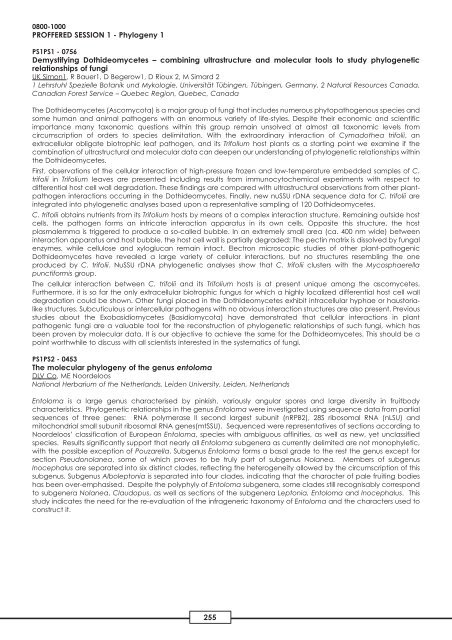Handbook Part 2 - International Mycological Association
Handbook Part 2 - International Mycological Association
Handbook Part 2 - International Mycological Association
You also want an ePaper? Increase the reach of your titles
YUMPU automatically turns print PDFs into web optimized ePapers that Google loves.
0800-1000<br />
PROFFERED SESSION 1 - Phylogeny 1<br />
PS1PS1 - 0756<br />
Demystifying Dothideomycetes – combining ultrastructure and molecular tools to study phylogenetic<br />
relationships of fungi<br />
UK Simon1, R Bauer1, D Begerow1, D Rioux 2, M Simard 2<br />
1 Lehrstuhl Spezielle Botanik und Mykologie, Universität Tübingen, Tübingen, Germany, 2 Natural Resources Canada,<br />
Canadian Forest Service – Quebec Region, Quebec, Canada<br />
The Dothideomycetes (Ascomycota) is a major group of fungi that includes numerous phytopathogenous species and<br />
some human and animal pathogens with an enormous variety of life-styles. Despite their economic and scientific<br />
importance many taxonomic questions within this group remain unsolved at almost all taxonomic levels from<br />
circumscription of orders to species delimitation. With the extraordinary interaction of Cymadothea trifolii, an<br />
extracellular obligate biotrophic leaf pathogen, and its Trifolium host plants as a starting point we examine if the<br />
combination of ultrastructural and molecular data can deepen our understanding of phylogenetic relationships within<br />
the Dothideomycetes.<br />
First, observations of the cellular interaction of high-pressure frozen and low-temperature embedded samples of C.<br />
trifolii in Trifolium leaves are presented including results from immunocytochemical experiments with respect to<br />
differential host cell wall degradation. These findings are compared with ultrastructural observations from other plantpathogen<br />
interactions occurring in the Dothideomycetes. Finally, new nuSSU rDNA sequence data for C. trifolii are<br />
integrated into phylogenetic analyses based upon a representative sampling of 120 Dothideomycetes.<br />
C. trifolii obtains nutrients from its Trifolium hosts by means of a complex interaction structure. Remaining outside host<br />
cells, the pathogen forms an intricate interaction apparatus in its own cells. Opposite this structure, the host<br />
plasmalemma is triggered to produce a so-called bubble. In an extremely small area (ca. 400 nm wide) between<br />
interaction apparatus and host bubble, the host cell wall is partially degraded: The pectin matrix is dissolved by fungal<br />
enzymes, while cellulose and xyloglucan remain intact. Electron microscopic studies of other plant-pathogenic<br />
Dothideomycetes have revealed a large variety of cellular interactions, but no structures resembling the one<br />
produced by C. trifolii. NuSSU rDNA phylogenetic analyses show that C. trifolii clusters with the Mycosphaerella<br />
punctiformis group.<br />
The cellular interaction between C. trifolii and its Trifolium hosts is at present unique among the ascomycetes.<br />
Furthermore, it is so far the only extracellular biotrophic fungus for which a highly localized differential host cell wall<br />
degradation could be shown. Other fungi placed in the Dothideomycetes exhibit intracellular hyphae or haustorialike<br />
structures. Subcuticulous or intercellular pathogens with no obvious interaction structures are also present. Previous<br />
studies about the Exobasidiomycetes (Basidiomycota) have demonstrated that cellular interactions in plant<br />
pathogenic fungi are a valuable tool for the reconstruction of phylogenetic relationships of such fungi, which has<br />
been proven by molecular data. It is our objective to achieve the same for the Dothideomycetes. This should be a<br />
point worthwhile to discuss with all scientists interested in the systematics of fungi.<br />
PS1PS2 - 0453<br />
The molecular phylogeny of the genus entoloma<br />
DLV Co, ME Noordeloos<br />
National Herbarium of the Netherlands, Leiden University, Leiden, Netherlands<br />
Entoloma is a large genus characterised by pinkish, variously angular spores and large diversity in fruitbody<br />
characteristics. Phylogenetic relationships in the genus Entoloma were investigated using sequence data from partial<br />
sequences of three genes: RNA polymerase II second largest subunit (nRPB2), 28S ribosomal RNA (nLSU) and<br />
mitochondrial small subunit ribosomal RNA genes(mtSSU). Sequenced were representatives of sections according to<br />
Noordeloos’ classification of European Entoloma, species with ambiguous affinities, as well as new, yet unclassified<br />
species. Results significantly support that nearly all Entoloma subgenera as currently delimited are not monophyletic,<br />
with the possible exception of Pouzarella. Subgenus Entoloma forms a basal grade to the rest the genus except for<br />
section Pseudonolanea, some of which proves to be truly part of subgenus Nolanea. Members of subgenus<br />
Inocephalus are separated into six distinct clades, reflecting the heterogeneity allowed by the circumscription of this<br />
subgenus. Subgenus Alboleptonia is separated into four clades, indicating that the character of pale fruiting bodies<br />
has been over-emphasised. Despite the polyphyly of Entoloma subgenera, some clades still recognisably correspond<br />
to subgenera Nolanea, Claudopus, as well as sections of the subgenera Leptonia, Entoloma and Inocephalus. This<br />
study indicates the need for the re-evaluation of the infrageneric taxonomy of Entoloma and the characters used to<br />
construct it.<br />
255









